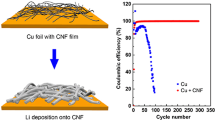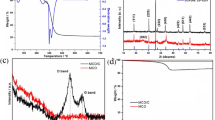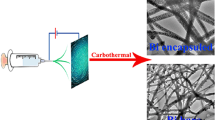Abstract
Lithium metal is considered to be the most promising anode material for the next-generation rechargeable batteries. However, the uniform and dendrite-free deposition of Li metal anode is hard to achieve, hindering its practical applications. Herein, a lightweight, free-standing and nitrogen-doped carbon nanofiber-based 3D structured conductive matrix (NCNF), which is characterized by a robust and interconnected 3D network with high doping level of 9.5 at%, is prepared by electrospinning as the current collector for Li metal anode. Uniform Li nucleation with reduced polarization and dendrite-free Li deposition are achieved because the NCNF with high nitrogen-doping level and high conductivity provide abundant and homogenous metallic Li nucleation and deposition sites. Excellent cycling stability with high coulombic efficiency are realized. The Li plated NCNF was paired with LiFePO4 to assemble the full battery, also showing high cyclic stability.
摘要
锂金属是未来二次电池实现高能量密度化的关键负极材料, 然而, 如何实现锂金属的均匀和无枝晶沉积是目前制约其实际应用的关键问题. 本论文采用静电纺丝技术及高温碳化方法制备了一种轻质、 高掺氮量(9.5 at%)的三维碳纳米纤维集流体. 该集流体较低的密度能提升基于整个电池的能量密度, 而且高掺氮量使其具备亲锂的特性, 从而有效降低锂离子在其表面的初始形核过电位, 得到均匀的金属锂种子层, 实现后续金属锂的均匀沉积. 这种三维结构有效抑制了锂枝晶的产生, 降低了电池的极化, 金属锂沉积/脱除测试中其库伦效率在循环250圈后仍可保持在98%以上. 将其沉积金属锂后与LiFePO4组装全电池, 电池极化降低, 在循环300圈后容量保持率可达82.4%, 表现出很好的应用前景.
Similar content being viewed by others
References
Armand M, Tarascon JM. Building better batteries. Nature, 2008, 451: 652–657
Goodenough JB. Energy storage materials: A perspective. Energy Storage Mater, 2015, 1: 158–161
Zhang C, Yang QH. Packing sulfur into carbon framework for high volumetric performance lithium-sulfur batteries. Sci China Mater, 2015, 58: 349–354
Palacín MR, de Guibert A. Why do batteries fail? Science, 2016, 351: 1253292–1253292
Xu K. Electrolytes and interphases in Li-ion batteries and beyond. Chem Rev, 2014, 114: 11503–11618
Li L, Chen C, Yu A. New electrochemical energy storage systems based on metallic lithium anode—the research status, problems and challenges of lithium-sulfur, lithium-oxygen and all solid state batteries. Sci China Chem, 2017, 60: 1402–1412
Bruce PG, Freunberger SA, Hardwick LJ, et al. Li–O2 and Li–S batteries with high energy storage. Nat Mater, 2012, 11: 19–29
Choi JW, Aurbach D. Promise and reality of post-lithium-ion batteries with high energy densities. Nat Rev Mater, 2016, 1: 16013
Cheng XB, Zhang R, Zhao CZ, et al. Toward safe lithium metal anode in rechargeable batteries: a review. Chem Rev, 2017, 117: 10403–10473
Xu W, Wang J, Ding F, et al. Lithium metal anodes for rechargeable batteries. Energy Environ Sci, 2014, 7: 513–537
Lang J, Qi L, Luo Y, et al. High performance lithium metal anode: Progress and prospects. Energy Storage Mater, 2017, 7: 115–129
Zhang C, Huang Z, Lv W, et al. Carbon enables the practical use of lithium metal in a battery. Carbon, 2017, 123: 744–755
Zhang Y, Qian J, Xu W, et al. Dendrite-free lithium deposition with self-aligned nanorod structure. Nano Lett, 2014, 14: 6889–6896
Heine J, Hilbig P, Qi X, et al. Fluoroethylene carbonate as electrolyte additive in tetraethylene glycol dimethyl ether based electrolytes for application in lithium ion and lithium metal batteries. J Electrochem Soc, 2015, 162: A1094–A1101
Zhao CZ, Cheng XB, Zhang R, et al. Li2S5-based ternary-salt electrolyte for robust lithium metal anode. Energy Storage Mater, 2016, 3: 77–84
Yan C, Cheng XB, Zhao CZ, et al. Lithium metal protection through in-situ formed solid electrolyte interphase in lithiumsulfur batteries: The role of polysulfides on lithium anode. J Power Sources, 2016, 327: 212–220
Li W, Yao H, Yan K, et al. The synergetic effect of lithium polysulfide and lithium nitrate to prevent lithium dendrite growth. Nat Commun, 2015, 6: 7436
Zhang XQ, Chen X, Cheng XB, et al. Highly stable lithium metal batteries enabled by regulating the solvation of lithium ions in nonaqueous electrolytes. Angew Chem Int Ed, 2018, 57: 5301–5305
Li NW, Yin YX, Li JY, et al. Passivation of lithium metal anode via hybrid ionic liquid electrolyte toward stable Li plating/stripping. Adv Sci, 2017, 4: 1600400
Qian J, Xu W, Bhattacharya P, et al. Dendrite-free Li deposition using trace-amounts of water as an electrolyte additive. Nano Energy, 2015, 15: 135–144
Chen R, Qu W, Guo X, et al. The pursuit of solid-state electrolytes for lithium batteries: from comprehensive insight to emerging horizons. Mater Horiz, 2016, 3: 487–516
Liu X, Ding G, Zhou X, et al. An interpenetrating network poly (diethylene glycol carbonate)-based polymer electrolyte for solid state lithium batteries. J Mater Chem A, 2017, 5: 11124–11130
Lu Q, He YB, Yu Q, et al. Dendrite-free, high-rate, long-life lithium metal batteries with a 3D cross-linked network polymer electrolyte. Adv Mater, 2017, 29: 1604460
Cheng XB, Yan C, Chen X, et al. Implantable solid electrolyte interphase in lithium-metal batteries. Chem, 2017, 2: 258–270
Koch SL, Morgan BJ, Passerini S, et al. Density functional theory screening of gas-treatment strategies for stabilization of high energy-density lithium metal anodes. J Power Sources, 2015, 296: 150–161
Ma L, Kim MS, Archer LA. Stable artificial solid electrolyte interphases for lithium batteries. Chem Mater, 2017, 29: 4181–4189
Wang L, Wang Q, Jia W, et al. Li metal coated with amorphous Li3PO4 via magnetron sputtering for stable and long-cycle life lithium metal batteries. J Power Sources, 2017, 342: 175–182
Zheng G, Lee SW, Liang Z, et al. Interconnected hollow carbon nanospheres for stable lithium metal anodes. Nat Nanotechnol, 2014, 9: 618–623
Zhu Y, He X, Mo Y. Strategies based on nitride materials chemistry to stabilize Li metal anode. Adv Sci, 2017, 4: 1600517
Li Q, Zhu S, Lu Y. 3D porous Cu current collector/Li-metal composite anode for stable lithium-metal batteries. Adv Funct Mater, 2017, 27: 1606422
Raji ARO, Villegas Salvatierra R, Kim ND, et al. Lithium batteries with nearly maximum metal storage. ACS Nano, 2017, 11: 6362–6369
Wang SH, Yin YX, Zuo TT, et al. Stable Li metal anodes via regulating lithium plating/stripping in vertically aligned microchannels. Adv Mater, 2017, 29: 1703729
Yang CP, Yin YX, Zhang SF, et al. Accommodating lithium into 3D current collectors with a submicron skeleton towards long-life lithium metal anodes. Nat Commun, 2015, 6: 8058
Yun Q, He YB, Lv W, et al. Chemical dealloying derived 3D porous current collector for Li metal anodes. Adv Mater, 2016, 28: 6932–6939
Zhang C, Lv W, Zhou G, et al. Vertically aligned lithiophilic CuO nanosheets on a Cu collector to stabilize lithium deposition for lithium metal batteries. Adv Energy Mater, 2018, 12: 1703404
Zhang YJ, Liu SF, Wang XL, et al. Composite Li metal anode with vertical graphene host for high performance Li-S batteries. J Power Sources, 2018, 374: 205–210
Zhang R, Li NW, Cheng XB, et al. Advanced micro/nanostructures for lithium metal anodes. Adv Sci, 2017, 4: 1600445
Cui J, Zhan TG, Zhang KD, et al. The recent advances in constructing designed electrode in lithium metal batteries. Chin Chem Lett, 2017, 28: 2171–2179
Lu LL, Zhang Y, Pan Z, et al. Lithiophilic Cu–Ni core–shell nanowire network as a stable host for improving lithium anode performance. Energy Storage Mater, 2017, 9: 31–38
Wiegrebe L. An autocorrelation model of bat sonar. Biol Cybern, 2008, 98: 587–595
Zhang R, Chen XR, Chen X, et al. Lithiophilic sites in doped graphene guide uniform lithium nucleation for dendrite-free lithium metal anodes. Angew Chem Int Ed, 2017, 56: 7764–7768
Liu L, Yin YX, Li JY, et al. Uniform lithium nucleation/growth induced by lightweight nitrogen-doped graphitic carbon foams for high-performance lithium metal anodes. Adv Mater, 2018, 30: 1706216
Frank E, Steudle LM, Ingildeev D, et al. Carbon fibers: precursor systems, processing, structure, and properties. Angew Chem Int Ed, 2014, 53: 5262–5298
Rahaman MSA, Ismail AF, Mustafa A. A review of heat treatment on polyacrylonitrile fiber. Polym Degrad Stab, 2007, 92: 1421–1432
Yan K, Lu Z, Lee HW, et al. Selective deposition and stable encapsulation of lithium through heterogeneous seeded growth. Nat Energy, 2016, 1: 16010
Acknowledgements
The authors acknowledge the financial support from the Guangdong Natural Science Funds for Distinguished Young Scholar (2017B030306006), the National Natural Science Foundation of China (51772164, U1601206 and U1710256), the National Key Basic Research Program of China (2014CB932400), and Shenzhen Technical Plan Project (JCYJ20150529164918734 and JCYJ20170412171359175).
Author information
Authors and Affiliations
Corresponding authors
Additional information
Haoliang Wu received his BSc degree in Applied Chemistry from Tianjin University in 2015 and continued his study as a master candidate under the guidance of Prof. Quan-Hong Yang till now. His research interest includes the design and fabrication of carbon nanostructure and novel electrode materials for energy storage devices.
Wei Lv received his PhD from Tianjin University in 2012 under the supervision of Prof. Quan-Hong Yang. He currently works as an Associate Professor in the Graduate School at Shenzhen, Tsinghua University. His research mainly focuses on novel carbon materials, such as graphene and porous carbons, and their applications in electrochemical energy storage.
Quan-Hong Yang was born in 1972, joined Tianjin University as a full professor of nanomaterials in 2006 and became a chair professor in 2016. His research is totally related to novel carbon materials, from porous carbons, tubular carbons to sheet-like graphenes with their applications in energy storage and environmental protection.
Rights and permissions
About this article
Cite this article
Wu, H., Zhang, Y., Deng, Y. et al. A lightweight carbon nanofiber-based 3D structured matrix with high nitrogen-doping level for lithium metal anodes. Sci. China Mater. 62, 87–94 (2019). https://doi.org/10.1007/s40843-018-9298-x
Received:
Accepted:
Published:
Issue Date:
DOI: https://doi.org/10.1007/s40843-018-9298-x




